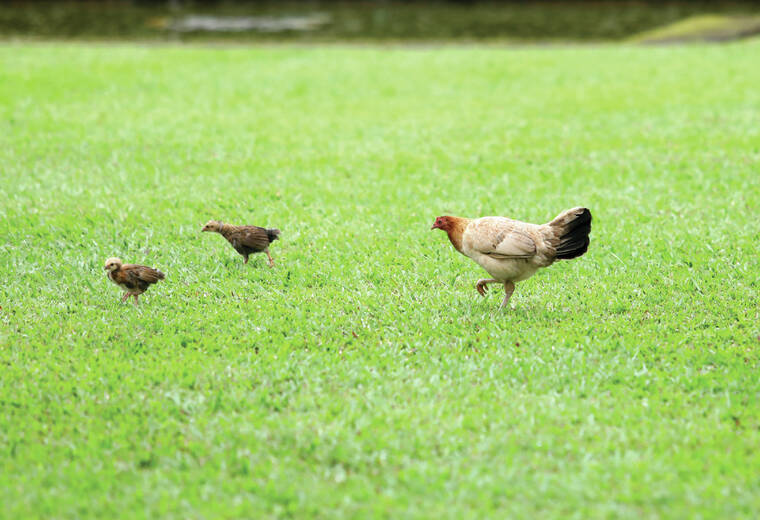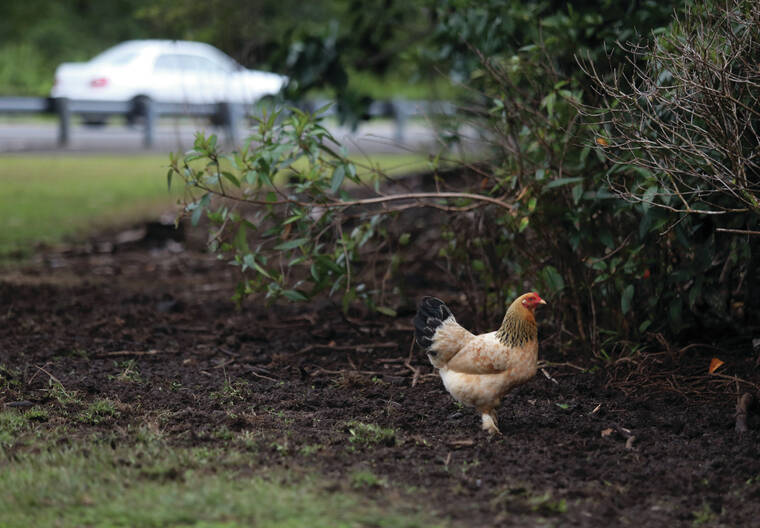A bill that would create a program to reduce the state’s feral chicken population is on the verge of passing the Legislature.
Senate Bill 2195 is proposal to establish a five-year pilot program between the state departments of Agriculture and Land and Natural Resources to “develop humane and cost-effective methods to manage the population of feral chickens in urban and suburban areas,” according to the current text of the bill.
The bill notes that feral chickens, which are particularly widespread on Kauai but are also common on the Big Island, are a nuisance species that constantly make noise, can damage nearby plant life, and can present a driving hazard by entering roadways. It also raises concerns that chickens can spread parasites and diseases to domestic chickens and other wild birds.
However, the bill does not go into any more specifics about what a feral chicken management program would entail. While the bill would allocate some money for the program, it does not specify how much.
Previous drafts of the bill are not any more specific. The only substantial change since the bill was first introduced was changing the managing state agency of the pilot program from the Department of Health.
Moreover, the bill has not been exactly popular throughout its committee hearings, particularly not among the agencies expected to operate the program. Back when it was to manage the program, the Department of Health opposed the bill on the grounds that it did not have sufficient staff.
At a committee hearing last Friday, the Department of Agriculture also opposed the bill, arguing that feral animal control issues fall outside the department’s purview.
And while the Department of Land and Natural Resources hasn’t directly opposed the bill, DLNR Chair Suzanne Case wrote before the Friday hearing that feral chickens are simply not hazardous enough to merit a five-year state pilot program.
“Although feral chickens can be hosts to numerous avian diseases including avian influenza, the department believes this threat is not a primary concern for protection and management of native wildlife,” Case wrote. “Feral chickens are not a game species nor an injurious species and are not under the department’s jurisdiction. Feral chickens primarily cause damage to food crops, human health and noise pollution and are better managed at the county level.”
Franny Brewer, spokeswoman for the Big Island Invasive Species Committee, said that BIISC does not consider feral chickens to be an invasive species, or at least, not one of significant concern.
“To be considered an invasive species, a species needs to have been introduced to an area, not native — and, yes, chickens are definitely introduced here,” Brewer said. “But they also have to do harm to local species, or the environment, or human settlements, or, in Hawaii, our way of life.”
Brewer said one could argue that feral chickens could spread mites to domestic fowl thatcould interfere with egg producing, but admitted that it would be a stretch to consider that scenario sufficiently harmful for an invasive species designation.
“They mostly spend time around human developments,” Brewer said. “They’re not going into the forest and competing or fighting with local birds.”
Brewer said feral chickens are, at worst, annoying, particularly on Kauai, where there are hardly any mongooses to steal chickens’ eggs.
Hilo Rep. Chris Todd voted Friday to pass the bill during the House Finance Committee Hearing, but with reservations. He told the Tribune-Herald Tuesday that he doesn’t imagine that the pilot program will accomplish much to actually address the problem.
“The Legislature needs to decide how much they want to deal with this problem,” Todd said. “The pilot program is just a half-measure.”
But, Todd acknowledged that the chicken problem has gotten worse in recent years, at least in Hilo.
“Growing up, we always used to joke about all the chickens on Kauai, but now they’re all over,” Todd said, adding that he noticed the birds becoming especially prevalent within the last decade.
“If we want to deal with this, we should tap our scientific experts, gather info and figure out what resources we need to do it,” Todd said. “But, really, the right time to deal with this was a long time ago.”
Email Michael Brestovansky at mbrestovansky@hawaiitribune-herald.com.









